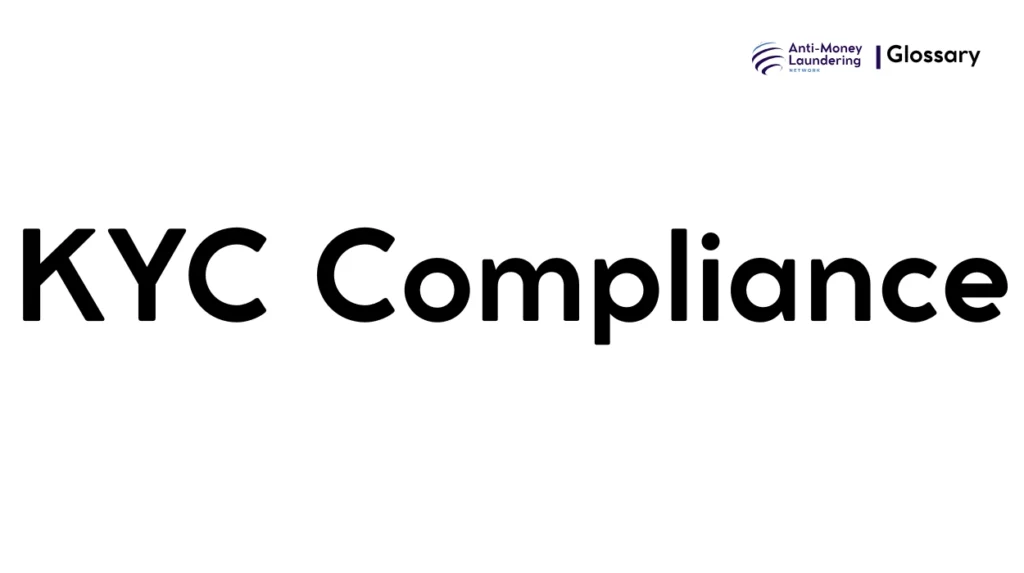Definition
KYC Compliance, or “Know Your Customer” compliance, is a fundamental component of Anti-Money Laundering (AML) practices. It refers to the process by which financial institutions and regulated entities verify the identity of their customers and assess associated risks before and during business relationships. This ensures that institutions are not inadvertently facilitating money laundering, terrorist financing, or other illicit activities.
Purpose and Regulatory Basis
KYC’s primary role in AML is to prevent criminals from using financial systems to launder proceeds of crime or finance terrorism. By establishing and verifying customer identities, institutions can monitor transactions and detect suspicious activities early.
Key global and national regulations mandating KYC compliance include:
- FATF (Financial Action Task Force): Provides international AML and KYC standards and recommendations to member countries.
- USA PATRIOT Act (2001): Requires US financial institutions to implement stringent KYC measures to combat terrorist financing.
- EU AMLD (Anti-Money Laundering Directives): European Union directives enforcing customer due diligence to prevent money laundering and terrorist financing.
These regulations emphasize a risk-based approach, requiring institutions to apply more rigorous checks for higher-risk customers.
When and How it Applies
KYC compliance is triggered at multiple points:
- Account Opening: Initial identity verification occurs before establishing a relationship.
- Transaction Monitoring: Ongoing checks during the business relationship to detect anomalies.
- Periodic Reviews: Scheduled risk reassessments of existing customers.
- Trigger Events: Changes in customer behavior, large cash deposits, or suspicious activity reports stemming from alerts or law enforcement.
Examples include banks verifying identification documents when opening accounts, insurance companies assessing risk profiles, and cryptocurrency exchanges confirming user identities before trading.
Types or Variants of KYC
KYC practices may vary depending on the customer risk profile and regulatory requirements. Common classifications include:
- Simplified Due Diligence (SDD): Applied to low-risk customers with straightforward profiles and limited transactions.
- Standard Due Diligence (CDD): The baseline level, requiring identity verification and screening.
- Enhanced Due Diligence (EDD): For high-risk customers, such as politically exposed persons (PEPs), large transactions, or clients from high-risk jurisdictions, requiring in-depth scrutiny.
Variants also exist based on delivery methods:
- Traditional KYC: Face-to-face verification with physical documents.
- Digital/Remote KYC: Online identity verification using biometric data, AI, and advanced technology.
Procedures and Implementation
Financial institutions implement KYC compliance using a structured process:
- Customer Identification Program (CIP): Collecting basic ID details such as name, date of birth, nationality, and address.
- Verification Methods: Checking government-issued IDs, passports, utility bills, or third-party verification services.
- Risk Assessment: Assigning risk ratings to customers based on geographic, sectoral, and behavioral factors.
- Ongoing Monitoring: Using automated systems to track transactions and flag suspicious activity.
- Record-Keeping: Storing KYC data securely for mandated retention periods.
Institutions typically integrate KYC into their AML management systems, ensuring compliance through staff training, audit trails, and independent reviews.
Impact on Customers/Clients
From a customer’s perspective, KYC involves:
- Rights: Customers have the right to privacy and data protection, governed by laws such as GDPR.
- Restrictions: Customers may face limitations on account operations or delays if verification is incomplete.
- Interactions: They must provide accurate information and timely updates; failure can result in account suspension or termination.
While sometimes perceived as cumbersome, KYC safeguards the overall integrity of the financial system and protects customers from fraud.
Duration, Review, and Resolution
KYC compliance is not a one-time activity but an ongoing obligation:
- Initial Verification: Conducted at account onboarding.
- Periodic Reviews: Scheduled based on risk classification, commonly annually or every few years.
- Ad-Hoc Updates: Triggered by significant changes such as address changes, new beneficial owners, or suspicious behavior.
- Resolution: Issues identified during reviews must be resolved promptly, which could include requiring additional information, restricting services, or closing accounts.
Reporting and Compliance Duties
Institutions bear key responsibilities under KYC compliance:
- Documentation: Maintaining comprehensive KYC files, verification documents, and audit logs.
- Suspicious Activity Reporting (SAR): Reporting any suspicious transactions or customers to financial intelligence units (FIUs).
- Regulatory Reporting: Ensuring compliance with local AML authorities’ directives.
- Penalties: Non-compliance can lead to heavy fines, sanctions, reputational damage, and legal consequences.
Related AML Terms
KYC is closely related to other AML concepts such as:
- Customer Due Diligence (CDD): The broader process of understanding the customer, of which KYC is a pivotal part.
- Beneficial Ownership: Identifying the natural persons who ultimately own or control a customer entity.
- Enhanced Due Diligence (EDD): Applied for high-risk cases.
- Suspicious Activity Monitoring: Processes that rely on KYC data to detect potential illicit activity.
- Customer Risk Profiling: Classifying customers based on AML risk factors.
Challenges and Best Practices
Common challenges include:
- Complex Customer Structures: Difficulty verifying ultimate beneficial owners in layered corporate entities.
- Data Privacy Concerns: Balancing AML requirements with customer privacy laws.
- Technology Integration: Ensuring digital KYC tools are effective and compliant.
- False Positives: Managing alerts to reduce unnecessary investigations.
Best practices to address these:
- Implementing a risk-based approach tailored to customer profiles.
- Employing advanced analytics and AI for verification and monitoring.
- Regularly updating policies in line with evolving regulations.
- Training staff continuously on AML and KYC standards.
Recent Developments
New trends in KYC compliance center on technological advancements and regulatory evolution:
- Digital Identity Verification: Use of biometrics, blockchain, and AI to streamline KYC while enhancing security.
- RegTech Solutions: Automation of compliance processes to reduce manual errors and operational costs.
- Global Regulatory Convergence: Greater alignment of AML/KYC rules across jurisdictions.
- Focus on Privacy Compliance: Harmonizing KYC obligations with data protection regulations like GDPR and CCPA.
These developments aim to make KYC more efficient, secure, and user-friendly while maintaining robust AML controls.
KYC Compliance is a cornerstone of effective Anti-Money Laundering frameworks, ensuring financial institutions verify their customers and mitigate risks of illicit activities. Grounded in international regulatory standards, KYC processes involve detailed customer identification, risk assessment, ongoing monitoring, and reporting obligations. Despite challenges, evolving technology and best practices continue to strengthen KYC’s effectiveness, safeguarding financial systems worldwide.

